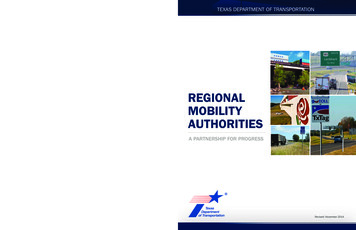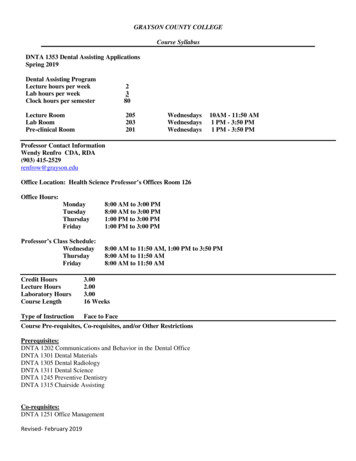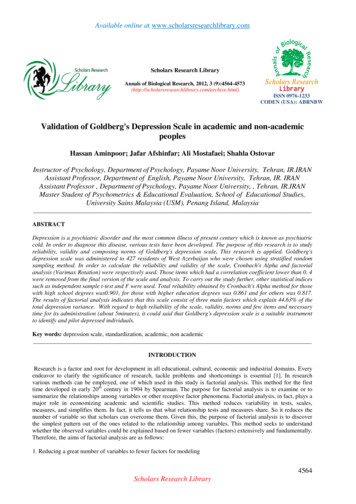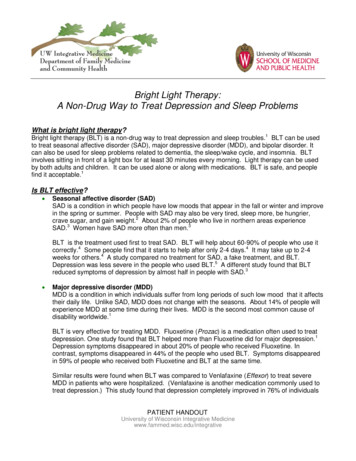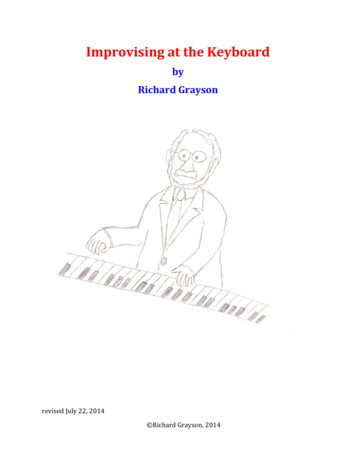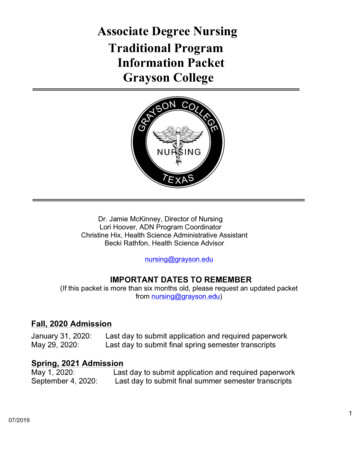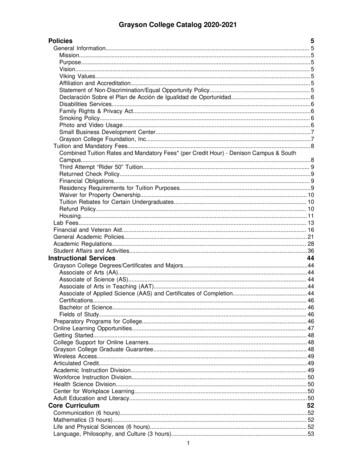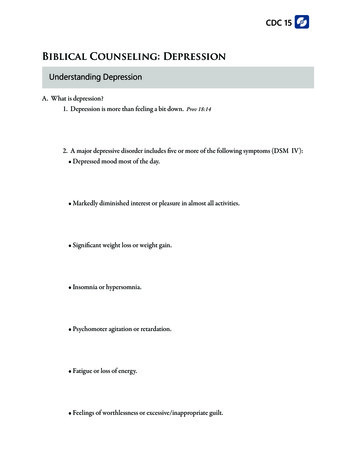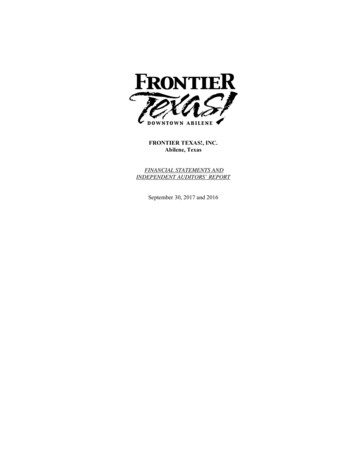
Transcription
GRAYSON COUNTY, TEXAS, IN DEPRESSION AND WAR: 1929‐1946David Park, B.A.Thesis Prepared for the Degree ofMASTER OF ARTSUNIVERSITY OF NORTH TEXASAugust 2009APPROVED:Randolph B. Campbell, Major ProfessorRichard B. McCaslin, Committee Member andChair of the Department of HistoryJ. Todd Moye, Committee MemberMichael Monticino, Dean of the Robert B.Toulouse School of Graduate Studies
Park, David. Grayson County, Texas, in Depression and War: 1929‐1946. Masterof Arts (History), August 2009, 156 pp., 2 tables, bibliography, 54 titles.The economic disaster known as the Great Depression struck Grayson County,Texas, in 1929, and full economic recovery did not come until the close of World War II.However, the people of Grayson benefited greatly between 1933 and 1946 from themyriad spending programs of the New Deal, the building of the Denison Dam thatcreated Lake Texoma, and the establishment of Perrin Army Air Field. Utilizing statisticaldata from the United States Census and the Texas Almanac, this thesis analyzes the roleof government spending‐federal, state, and local‐in the economic recovery in GraysonCounty.
ŽƉLJƌŝŐŚƚ ϮϬϬϵ ďLJ ĂǀŝĚ WĂƌŬ ii
TABLE OF CONTENTSPageCHAPTER I: THE GREAT DEPRESSION IN GRAYSON COUNTY, 1929‐19331CHAPTER II: SAM RAYBURN28CHAPTER III: THE FIRST NEW DEAL IN GRAYSON COUNTY, 1933‐193538CHAPTER IV: THE SECOND NEW DEAL IN GRAYSON COUNTY, 1935‐193960CHAPTER V: THE DENISON DAM AND DEVELOPMENT INGRAYSON COUNTY, 1939‐194198CHAPTER VI: WAR YEARS IN GRAYSON COUNTY, 1941‐1945124CHAPTER VII: EPILOGUE AND CONCLUSION142WORKS CITED152iii
CHAPTER ITHE GREAT DEPRESSION IN GRAYSON COUNTY, 1929‐1933There have been many crises in the history of our country. We have hadwars; we have had depressions; we had a war between the States whenthe lightning of sectional antagonism threatened to shatter this mightyRepublic. We had the panic of 1873, of 1893, and 1914 to 1918 the earthwas swallowed up in the greatest reign of madness it had ever known,when ideals were shattered and hearts were made sick.In my opinion, the most serious, far‐reaching and dangerous crisis thatever threatened this country were the years from 1929 until March 4,1933. More people had lost the faith of their childhood in governmentsand in men and had done it to such an extent that we stood upon theverge of disaster.‐ Sam RayburnTexas, the United States, and indeed nearly the entire world, experiencedmassive changes between the years 1929 and 1946, beginning with an internationalfinancial crisis, followed by a second world war. During this time, the Lone Star Stateencountered unprecedented growth that transformed it from a primarily rural,agricultural state into the industrial giant it is today. While major industrial centers,such as Dallas, Fort Worth, and Houston, were obviously and unquestionably changedthroughout these years, the Great Depression and World War II also had a major impacton many of the State’s essentially agricultural areas such as Grayson County in NorthTexas. How exactly, did the Great Depression affect Grayson County? How effectivewere the New Deal programs in dealing with the Depression in that North Texas county?1
How did Grayson acquire the Denison Dam and Perrin Army Air Field, and what did theymean to the county’s economy? What ultimately brought Grayson County out of theDepression and Why? Through an examination of Grayson County during the formativeyears from 1929 to 1946, these questions will be answered.Very little has been written about Grayson County in general, especially withregard to the region during the twentieth‐century. Most of the works that do exist fallinto the categories of either “personal anecdotes” or “promotional pamphlets”. Thepurpose of this thesis is to provide a narrative account and an in depth analysis of thecountry’s history during the Great Depression and World War II.1Located in north central Texas, Grayson County is situated between the RedRiver to the north, Fannin County to the east, Cooke to the west, and Collin and Dentonto the south. Organized from Fannin, Grayson was founded on March 17, 1846, by anact of the Texas legislature, and named for the Attorney General of the Republic ofTexas, Peter W. Grayson. The same legislation also designated that the County seat becalled Sherman (in honor of General Sidney Sherman, a hero of the Battle of San Jacintoduring the Texas Revolution), as a way to compromise between supporters of the pro‐Houston Democrat Grayson and the anti‐Houston Whig Sherman. Within four years of1Examples of personal anecdotes are: Grayson County Frontier Village, The History of Grayson County,Texas (Tulsa: Heritage Publishing Company, 1981); Jerry Bryan Lincecum and Roland Carlisl Vaughan, TheLife and Times of Grayson County, Texas (Sherman: Big Barn Press, 2006); Don Eldredge, Reflections:Sharing Sherman and Grayson County’s Past, vol. I (Marceline: D‐Books Pub., 1994); and, Don Eldredge,Reflection II: Grayson County’s Past (Marceline: D‐Books Pub., 1996). Examples of promotional pamphletsare: Ed. I. Anderson, History and Business Guide of Sherman, Denison and Grayson County, Texas (‐‐‐‐,1948); Jack Maguire, A Short History of Denison, Texas, “The Gate City” (Denison: F.W. Miller Print Co.,1938); Charles A. Spears, Your town: Past, Present, Future (Sherman: Grayson Bank, 1967); and NeilsonRogers and Joe C. Henderson, Grayson County, Where the West Began (Sherman: A‐1 Print Co., 1998).2
its founding, Grayson had a population of 2,008, and reported eleven public schools(only six counties throughout Texas could claim more) and 35 churches. The county’sfarmers worked 5,891 improved acres.2During the 1850s, Grayson was the most important county of the region becauseit marked a major division point on the route to California, especially in 1858 whenSherman was designated a way station stop of the Butterfield Overland Route to SanFrancisco. Thus, by the census of 1860, the population had increased to 8,184, thenumber of improved acres of farm land to 40,775, and businessmen had begun tooperate mills for flour and corn meal.3Following the Civil War, from 1870 to 1880 Grayson County experienced growthunparalleled in its entire history due to the arrival of several railroad lines. Shermanobtained a link to the Houston and Texas Central Railroad in 1872, but its residents didnot provide the incentive to appeal to the officials of the Missouri, Kansas and TexasRailroad (Katy) for a similar connection. Instead, railroad executives created thetownsite of Denison (named after George Denison, the vice president of the Katy), andthe company entered Texas from the North when the very first train arrived onChristmas Day, 1872. This connection was the first to a national rail system thatextended to the Northeast, and, once Denison also obtained stops from the St. Louis,2The Texas Almanac and State Industrial Guide (Dallas: A. H. Belo & Co., 1952), 551‐552; Ron Tyler,Douglas E. Bornett, Roy R. Barkley, Penelope C. Anderson, and Mark F Ordinits (eds.), The New Handbookof Texas (6 vols.; Austin: Texas State Historical Association, 1996), III, 298 (Grayson County); V, 1021(Sherman, Texas); Donna J. Kumler, “’They Have Gone From Sherman’: The Courthouse Riot of 1930 andits Impact on the Black Professional Class” (Ph.D. diss., University of North Texas, 1995), 16.3Tyler, Bornett, Barkley, Anderson, and Ordinitz (eds.), Handbook of Texas, III, 298 (Grayson County); V,1022 (Sherman); Kumler, “They Have Gone”, 16‐17.3
San Francisco and Texas, and the Kansas, Oklahoma and Gulf railroads, it became thecounty’s primary rail town. By 1882, just ten years after the first rail line arrived in thecounty, there were over 100 miles of track in Grayson.4With the rail lines came new industries, including two cotton presses, a largeflour mill and a slaughterhouse in Denison, and five flour mills and the largest grainelevator north of Dallas in Sherman. By 1880 there were thirty‐seven manufacturingestablishments in Grayson County, with flour and grist mills accounting for twenty‐twoof the businesses. As a result of this expansion of the railroads and manufacturing,between 1870 and 1880 the population of Grayson County increased 254 percent from14,387 to 38,108, and the number of farms rose by 460 percent. The value of real estatejumped from 1,224,069 to 4,352,986, and personal property from 641,826 to 2,707,760. With such growth, several new towns were created, including Van Alstyne,Howe, Whitewright, Pottsboro, and Tom Bean. Grayson County was now a leadingagricultural, marketing and milling center of North Texas.5Grayson County and both Sherman and Denison continued to expand during thelate nineteenth century, gaining additional rail lines, manufacturing and millingindustries. In the first two decades of the twentieth century, two new lines wereextended into Grayson County, giving it ten railroads and outlets in every direction to4Tyler, Bornett, Barkley, Anderson, and Ordinitz (eds.), Handbook of Texas, II, 594 (Denison, Texas); III,298 (Grayson County); V, 777 (Missouri‐Kansas‐Texas Railroad); V, 1022 (Sherman, Texas); Kumler, “TheyHave Gone”, 20.5Tyler, Bornett, Barkley, Anderson, and Ordinitz (eds.), Handbook of Texas, II, 594 (Denison, Texas); III,298 (Grayson County); V, 1022 (Sherman, Texas); Kumler, “They Have Gone”, 21.4
nearly every part of the country. The state’s first electric interurban railway was alsoestablished during this time, linking Sherman to Denison, and eventually (afterbecoming part of the Texas Electric Railway Company) making Denison the northernterminus on a line that ran through Dallas to Waco.6Such connections meant more manufacturing business, and by 1910 Graysonhad “forty‐seven gins, five cottonseed oil mills, two cotton factories, four saw mills,eight flouring mills, several machine shops, brick plants, ice factories, broom factories,etc.” Between the censuses taken in 1909, 1914 and 1919, Grayson’s main citiesexperienced major growth in their value of manufactured products. In Denison, whichwas home to a major Katy Railroad repair and construction shop (the city’s primaryindustry), the value increased by 286.5 percent, from 1,313,785, to 2,068,788, andthen 5,077,916 by 1919. In the same period, the value of manufactured products inSherman rose 310.1 percent, from 4,675,971 to 7,027,747 to 19,175,558, and by1920, the city manufactured “more per capita in dollar volume than any otherSouthwestern city her size and four times as much as any other Southwestern city of25,000 people.” Thus, by 1919 the county ranked sixth in the state in value ofmanufactured products.76Tyler, Bornett, Barkley, Anderson, and Ordinitz (eds.), Handbook of Texas, V, 1022 (Sherman, Texas); TheTexas Almanac and State Industrial Guide (Dallas: A. H. Belo & Co., 1925), 284; The Texas Almanac andState Industrial Guide (Dallas: A. H. Belo & Co., 1926), 237‐238; Kumler, “They Have Gone”, 32.7United States Bureau of the Census, Fourteenth Census of the United States, State Compendium: Texas(Washington: Government Printing Office, 1925), 226, 245; The Texas Almanac and State Industrial Guide(Dallas: A. H. Belo & Co., 1910), 197‐198 (first quote); Texas Almanac (1925), 284 (second quote), 285;Texas Almanac (1926), 237‐238; Kumler, “They Have Gone”, 32. Grayson ranked sixth in value ofmanufactured products behind Tarrant, Dallas, Harris, Bexar, and El Paso counties.5
In spite of such advances in manufacturing, Grayson County remainedpredominately agricultural. Although the number of farms decreased slightly from5,762 in 1900, to 5,720 in 1910, and 5,569 in 1920, this development was commonthroughout the South and West, primarily due to urbanization. But this trend did notmean that farming as a business was doing poorly. In fact, quite the opposite was true:in the censuses from 1900 to 1920, the value of all farm property in Grayson Countyincreased from 16,691,607 to 27,941,505 in 1910, to 64,617,801 in 1920, decennialgains of 67.4 and 131.3 percent.8Attributable to the expansion of the rail lines, growth in manufacturing, andstrong agricultural production, from 1890 to 1920, the population trends of GraysonCounty emulated those of Texas, with a steady rise in the total number of inhabitantsand also citizens residing in urban areas. From 53,211 residents in 1890, the number ofpersons in Grayson County rose steadily in the next three decades to 74,165 by 1920, anincrease of almost 40 percent. Most of this growth occurred in the cities of Sherman andDenison, and, accordingly, the percentage of people living in urban areas increased from34.6 percent in 1900 to 43.3 percent in 1920.98Bureau of Census, Fourteenth Census, State Compendium: Texas, 116; Kumler, “They Have Gone”, 31.All farm property includes land, buildings, implements and machinery, and livestock.9Bureau of Census, Fourteenth Census, State Compendium: Texas, 34, 53; United States Bureau of theCensus, Fifteenth Census of the United States: 1930; Population, Volume I: Number and Distribution ofInhabitants (Washington: U.S. Government Office, 1931), 1059; United States Bureau of the Census,Sixteenth Census of the United States: 1940; Population, Volume I: Number of Inhabitants (Washington:U.S. Government Printing Office, 1942), 1042. “Urban” refers to cities with populations of 2,500 or more,which includes only the cities of Denison and Sherman in Grayson County. Both places experiencedcontinuous growth during this period, with Denison’s population rising from 10,958 in 1890 to 17,065 in1920, and Sherman’s from 7,335 in 1890 to 15,031 in 1920.6
Throughout the 1920s, the United States and Texas experienced the “prosperitydecade,” a period of economic expansion in commercial and business construction, andnew industrial manufacturing. Although businessmen and politicians talked of a “NewEra” for the economy in which poverty was being eliminated, there were underlyingweaknesses of the period, namely the financial hardships of the farmers, and theoverconcentration of wealth in too small a group of individuals. While Texas’sexperience during the prosperity decade was similar to that of the United States withsome differences in the details, for Grayson County the weaknesses of the decade wererealized and compounded by a contraction of business and manufacturing, and the onlydecennial population decrease in the county’s history.10A comparison of manufactures according to census records illustrates themarked difference of the prosperity decade between Texas and Grayson County. From1919 to 1929, the manufacturing industry in Texas showed impressive gains, with thenumber of business establishments rising by 45.8 percent (from 3,566 to 5,198), thenumber of wage workers by 51.6 percent (from 88,707 to 134,498), wages by 46.1percent ( 103,945,662 to 151,827,257), and the value of manufactured products by72.1 percent ( 842,438,135 to 1,450,246,431). In contrast, Grayson County showedlosses in almost all categories of manufacturing: the number of establishmentsdecreased by 40.1 percent (from 137 to 81), and wage earners by 10.5 percent (from2,461 to 1,750); wages were reduced by 20.7 percent ( 3,118,399 to 2,471,844; cost of10Randolph B. Campbell, Gone to Texas: A History of the Lone Star State (New York: Oxford UniversityPress, 2003), 360.7
materials fell by 33.1 percent ( 23,930,732 to 16,010,300); and the value ofmanufactured products declined by 23.0 percent ( 30,612,624 to 23,555,945).11The only category of manufacturing that saw a gain in the census figures forGrayson County during the 1920s was the “value added by manufacturing.” Becausethis is considered the most accurate measure of industrial profit, it is noteworthy that itis the only facet of manufacturing in Grayson County that experienced growth, from 6,681,892 in 1919 to 7,545,645 in 1929, an increase of 12.9 percent. Wages fellalmost twice as far as the number of wage earners, and the cost of materials decreased30.2 percent more than did the value of products, suggesting that the manufacturingindustries in Grayson County, by cutting expenditures (wages and cost of materials) at agreater ratio than their means of production (wage earners), realized less decline invalue of products than cost of materials, increasing their overall added value.Therefore, the 12.9 percent increase in value added was afforded to proprietors, firmmembers, salaried officers, managers and others that (when coupled with the decrease11The Texas Almanac and State Industrial Guide (Dallas: A. H. Belo & Co., 1927), 231; The Texas Almanacand State Industrial Guide (Dallas: A. H. Belo & Co., 1929), 170; The Texas Almanac and State IndustrialGuide (Dallas: A. H. Belo & Co., 1936), 286; Bureau of Census, Fourteenth Census, State Compendium:Texas, 223; United States Bureau of the Census, Fifteenth Census of the United States, Manufactures:1929; Volume III: Reports by States (Washington: U.S. Government Printing Office, 1933), 507, 508. Alldifferences in dollar amounts are not adjusted for inflation. However according to the FederalGovernments inflation calculator (at http://data.bls.gov/cgi‐bin/cpicalc.pl), 100 in 1919 had the samebuying power as 98.84 in 1929, representing only a 1.2 percent difference. Figures only from 1919 and1929 because the biennial census of manufactures for the decade gives no statistics by county.8
in wages of manual workers) added to the discrepancy between the economic classes inGrayson, effectively making the rich richer and the poor poorer.12As with their counterparts in the rest of the country, Grayson County farmers didnot experience prosperity during the 1920s. During the decade, the number of farms inthe county decreased from 5,569 to 5,169, the percentage of farms operated by tenantsincreased from 60.8 to 65.6, and the value of all farm property declined from 64,617,801 to 33,671,684, a loss of 47.9 percent. However, despite such losses, thepercent of Grayson County used for farm land increased during the decade from 84.3 to89.3, and the average acreage per farm rose from 91.3 to 104.2. Additionally, while thenumber of farms in the 100 acres or more categories all showed modest gains, nearly allof the smaller farm groups showed losses. These figures demonstrate a combination ofthe two weaknesses of the decade: as the agricultural industry in Grayson County facedfinancial hardships, smaller farmers were forced to sell their land to more prosperousones, creating a larger discrepancy between the affluent and impoverished among thefarm populace.1312Bureau of Census, Fifteenth Census: Manufactures, 8 (quote). “Value added by manufacturing”measures the “net addition to the value of commodities in existence,” by subtracting the cost of materialsfrom the value of the products. Cost of materials includes “cost of materials, containers for products, fuel,and purchased electric energy used during the census year,” effectively all costs except salaries andwages.13Bureau of Census, Fourteenth Census, State Compendium: Texas, 116; United States Bureau of theCensus, Fifteenth Census of the United States: 1930; Agriculture, Volume II, Part 2: The Southern States(Washington: U.S. Government Printing Office, 1932), 1369, 1409, 1431. The categories of farm sizes byacreage in Grayson County are: under 3; 3 to 9; 10 to 19; 20 to 49; 50 to 99; 100 to 174; 175 to 259; 260to 499; 500 to 999; 1,000 to 4,999; and 5,000 and over. All categories of 100 acres or more experiencedgrowth (except the 5,000 and over, in which there were none in the county), totaling 240 new farms. Incontrast, in groups with 99 acres or less, the total loss was 668 farms, with the two numerically largest9
In population, Texas grew by more than one million persons between 1920 and1930, the greatest numerical increase in the history of the State to that point. Incontrast, Grayson was one of the sixty‐nine counties in the state that lost populationbetween 1920 and 1930; having risen to
Park, David. Grayson County, Texas, in Depression and War: 1929‐1946. Master of Arts (History),
